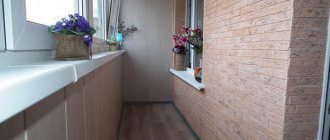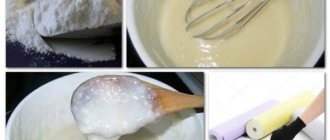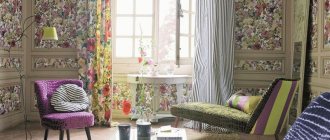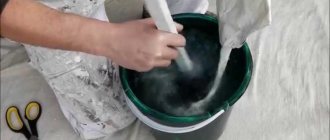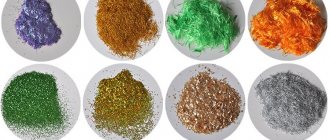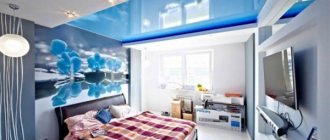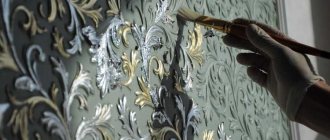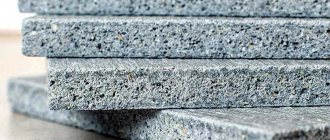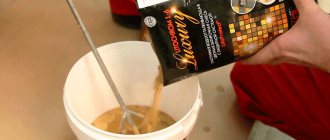Home / Ceiling design / Design solutions / Types, pros and cons of fabric wallpaper for walls
With the help of unusual finishing options you can transform any room. One of these unusual solutions in the interior can be fabric wallpaper for walls. This is a specific type of decoration that allows you to give the room a luxurious look. There are quite a lot of options for such coatings in stores, but not everyone is familiar with the pros and cons of such a design. Let's try to find out what is good or bad about this type of finishing, as well as its main features.
What it is
Before you stick fabric on the wall instead of wallpaper, you need to find out how they are produced and what initial components are used for this. Modern materials of this type are produced on special machines that cover a paper or non-woven base with a layer of textile fiber. Depending on which fiber is used, the appearance of the coating changes and it acquires special properties. This material looks very similar to real textiles and that is why such wallpapers are often called “fabric”.
Criteria for choosing textile wallpaper
The most affordable is a coating made of threads glued to the base. Their density per 1 cm ranges from 10 to 250. Such models are produced in one color, and the tone is determined by the thickness of the thread, which adds naturalness to them. They fit perfectly into any design and create the necessary background for paintings and lamps. Installation is done without adjusting the pattern, and the joints are invisible. Thread models with rapport, indistinguishable from the fabric itself, began to appear. Varieties using textiles instead of threads are much stronger, but also much higher in price.
When choosing fabric wallpaper for the bedroom, it is better to choose silk or plush options. For small rooms you should choose different shades of the same color and pattern. This will make the interior harmonious and expand the space. When installed on the wall, textile fabrics form noticeable joints, so it would be preferable to choose wide stripes. In stores you can find rolls up to 3 meters wide. If the height of the ceiling corresponds to the size of the canvases, then it is better to glue them horizontally, generally without joints.
♥Note: article on the website “Care for wooden windows with double glazing”.
Models in milky tones, as well as bright red and blue with floral patterns and vertical stripes, are popular. Textile wallpaper with added golden threads will add pathos and luxury to the interior. Colors imitating natural materials - animal and reptile skin or tree bark - are in high demand. When choosing a coating, it is better to give preference to textile wallpaper on a non-woven basis, as they are able to hide minor defects and do not shrink.
Varieties
Modern fabric wallpaper for walls presented in construction stores can be of several types. The differences lie in the different materials used for the outer covering:
- Linen. The base is covered with a layer of flax fiber, which is of natural or artificial origin. Externally, they imitate real linen as accurately as possible.
- Silk. Despite this name, silk is practically not used in the manufacture of such coatings. Basically, the outer layer consists of viscose mixed with very small amounts of natural silk fibers. At the same time, everything looks very realistic.
- Felt. This type of fabric is made from natural felt or its artificial substitute - polypropylene. They are quite dense and thick, thanks to which they provide additional sound and heat insulation.
- Jute. The outer layer here is a natural fiber interspersed with coarse linen threads. This provides the canvas with good resistance to stains and durability. In addition, they do not attract dust.
- Velor. They differ from the others in the manufacturing method - a paint-coated paper base is passed through a special installation, which covers the not yet dried applied paint layer with small textile fibers due to an electrostatic field. They can have different textures and imitate fabrics such as velor, velvet, tapestry and so on.
- Jacquard. Their main difference is the large width of the canvas - up to three meters. This, on the one hand, increases the speed of finishing, and on the other, creates certain difficulties when carrying out repairs, since covering the walls with such a wide fabric will not be an easy task.
The choice is wide and in general it will be very large, since each type of wallpaper from the list presented above has several varieties. However, before you decide to stick fabric to the wall instead of wallpaper, you need to find out what advantages or disadvantages they have.
How to paste textile wallpaper
Before finishing, it is necessary to get rid of the old coating, adhesive residues, loose layers of paint and plaster. If walls are suspected of being infected (fungus, mold), they must be treated with antibacterial compounds. Defects are repaired with putty and thoroughly cleaned. The surface is then primed or coated with a layer of oil-based enamel. This procedure is necessary so that the fabric wallpaper on the walls does not sag after gluing. The enamel-coated surface must be treated with sandpaper or a strong alkali solution, followed by rinsing with water to make it rough.
The color of the materials used for preparation must match or be close to the tone of the wallpaper. Otherwise, the total shade after mixing them may differ from the purchased canvases.
To reduce the labor intensity of further work, you need to stick the paper backing on the wall in horizontal stripes so that its joints do not coincide with the joints of the coating. You can glue the canvases after a couple of days so that the substrate has time to guarantee drying.
Advantages and disadvantages
In order to make a more informed decision when planning repairs and choosing the type of design, you need to highlight the main advantages and disadvantages of a particular design option. It’s best to start with the advantages characteristic of textile coverings:
- They look great. This is the main “trump card” of this type of design. No other material will look so luxurious.
- Long service life - due to the strength of the outer layer, the coating can last for several decades if properly handled.
- Additional heat and sound insulation is created.
- Naturalness - the outer covering consists in most cases of real textiles or fibers. Therefore, fabric wallpaper for walls can be used in the interior of a children's room without fear for the health of children.
Unfortunately, such a beautiful design also has its drawbacks. When gluing fabric instead of wallpaper on the wall, you need to read the following disadvantages:
- Most varieties of such wallpaper attract dust and are quite difficult to clean.
- If paper is used as a base, the canvas will not be waterproof.
- They will absorb odors and therefore it is not recommended to use such materials to decorate the kitchen area.
- After gluing, paper-based varieties may become deformed and therefore, the best option would be varieties with non-woven bases.
- When exposed to sunlight, the material will gradually fade and lose its brightness.
In addition, fabric wallpaper for walls has a very high cost and that is why some people make it themselves. This is not a very complicated process, but getting a decent result comparable to factory products is very difficult.
Advantages and disadvantages
Textile wallpaper is the best type of high-quality wall covering. Their unsurpassed beauty and design are always appreciated, but their performance characteristics are also considered important:
- versatility of application. Thanks to the rich colors and variety of textures of the top layer, fabric wallpaper can be used in the interior of bedrooms, offices, living rooms, when decorating rooms in private homes, in museums and government institutions;
- environmental cleanliness;
- resistance to external factors: moisture, ultraviolet radiation, etc.;
- maintaining a comfortable indoor microclimate;
- service life - 10−15 years.
Combination of several types
But the main advantage of fabric wallpaper is its beauty and luxury, as well as a diverse range of models.
On a note! The only drawback of such materials is their fragility and susceptibility to damage. They also cannot boast of good antistatic properties, so textile wallpaper is a place where dust and dirt accumulate, which are difficult to get rid of.
Silk wallpaper for a cozy bedroom
Note! Almost all types of textile wallpaper are not moisture resistant and are not intended for wet cleaning. Only dry cleaning with a soft cloth or very careful cleaning with a vacuum cleaner is permissible.
An interesting option for a child's room
What does it look like
It can be quite difficult to imagine how this or that material looks in design. To get a more complete idea of what fabric wallpaper for walls looks like in various interiors, you can view several photo examples of such finishing below.
The procedure for decorating walls with fabric
- If there is a chimney or various cracks on the wall, they must be eliminated with putty or by gluing plastic film so that dark spots do not appear on the fabric.
- Before you start decorating the walls with fabric, you need to calculate the number of strips that will frame the fabric and decide in what order the walls will be decorated.
- To do this, you can draw a small plan on which to indicate the location of the planks, as well as where the sockets, switches, etc. will be located, and on the same plan number the order of the walls.
- The fabric panel is prepared in accordance with the size of each wall. If the fabric is small in width, then you can sew several panels into one, equal to the width of the wall.
- When preparing fabric of large width, it is necessary to cut it with a margin of 15 - 20 centimeters to allow the upholstery to be stretched during application. After gluing the fabric to the walls, marks are made on the wrong side and wound onto a cardboard tube before gluing them together.
- Gluing the fabric requires the participation of two people. You need to glue the fabric along four edges. The edge of the wall is smeared with glue, the width of the strip should be at least 10 centimeters, unwind the roll of fabric a little and apply it to the wall from the ceiling to the floor, while you need to leave a small supply of fabric near the ceiling, floor and on the wall.
- One person needs to hold the roll, and the second one needs to smooth the fabric with a roller.
- After gluing along the edges, the upper part of the wall is smeared with glue, then the first person unwinds the roll, and the second person glues the upper edge, smoothing it.
- After the glue has dried, it is the turn of the right and bottom edges of the fabric.
- You can glue it in a different order, first the top edge, then the sides, and finally the bottom. More often, not all walls are covered with fabric, but one or two, or part of the wall.
Other ways to decorate with fabric
The walls are not only covered with fabric, but also covered. This technique is similar to the installation of suspended ceilings and in this case you cannot do without the help of specialists. All the necessary materials for this can be purchased from the company from which the wall covering is ordered.
The walls can also be draped. Fabric wider than the width of the wall, folded in several layers and secured to a thin curtain that is nailed to the ceiling. Drape the fabric itself in waves.
At first glance, decorating a wall with fabric may seem more expensive, but if you pay attention to how much it takes to install, you will see that fabric is simpler and cheaper than wallpapering.
The brightness and clarity of the image on the fabric is ensured by the latest dyeing technologies, so the coating will be like new for a long time. In addition, fabrics for covering walls are impregnated with water-repellent agents, protecting them from the negative effects of sunlight and high humidity in the room. In a room with fabric-covered walls, there is less deposited dust.
Installation technology
The process of gluing this material is complex and painstaking. Before you start working, you need to become familiar with a number of nuances.
- It is easier to work with a non-woven coating: it is stronger, the glue must be applied to the wall, and not to the wallpaper, which practically eliminates its getting on the front side of the coating (this can lead to stains that cannot be removed with anything).
- To work you need special glue. This coating is very heavy, and glue stains may remain on it, which is taken into account by manufacturers of adhesive compositions.
- After applying the glue, the canvas needs to soak for at least 10 minutes.
- You can’t bend textile wallpaper, otherwise you won’t be able to straighten it later.
- The enemies of fabric covering are glue and water on the front side. Hands must be dry when working. The glue layer is thin and uniform.
- You cannot use a plastic spatula: it drives the glue into the seams, and stains form on the canvas. Experts recommend smoothing textile wallpaper for walls with a rubber roller from top to bottom.
For work you will need the following tools and materials:
- plumb line;
- pencil;
- scissors;
- roller with fine pile (for glue);
- glue container;
- rubber roller (for smoothing wallpaper);
- wallpaper;
- special glue.
Stage 1 – surface preparation
All old coating must be removed. All large defects are puttied. There should not be a spider web on the surface: it can appear through the fabric. The walls are leveled if necessary.
Stage 2 – priming
The walls are treated with a deep penetration primer or the same adhesive that will be used to glue the wallpaper. You need to let the surface dry completely.
Textile wallpaper for wall decoration
Textile wallpaper is essentially a textured wallpaper for walls that is made from natural fibers, man-made yarns or a mixture of both, creating a wide range of surface finishing effects. They can be paper or non-woven to create eye-catching wall coverings.
Textile wallpaper comes in many different varieties. Natural textile wallpapers are made from natural fibers that are glued onto a paper or vinyl backing, which increases their durability. Depending on the manufacturing process, the fabric can appear either fine or rough. Either way, it adds a sense of dimension to the walls, enhancing the visual appeal of the room. Wallpaper made from synthetic textiles imitates the appearance of natural textiles. Because they are not made from natural materials, they are more suitable for high-traffic areas.
Types of textile wallpaper
Depending on the composition of the material, they can be made from threads, from a single piece of fabric, or from very dense fabric. The material has a stunning appearance, looks expensive and exclusive.
- Silk wallpaper, with walls covered in silk, is shameless luxury and a statement piece. The hand-spun nature of wild silk creates a look that sets silk wallpaper apart from any other.
- Linen wallpaper using high quality linen to create a natural, luxurious finish.
- Fabric wallpapers come in a variety of natural shapes and materials such as sisal, jute and reed. These materials are hand-woven and painted with water-based paints to create wall finishes characterized by variations in texture and color, enhanced by the natural fibers used to create this exquisite wallpaper.
Most textile wallpapers are made on a non-woven basis, which greatly simplifies their gluing. They are easily applied to rough or uneven surfaces with simple installation instructions.
Advantages of textile wallpaper
Fabric wallpaper has a lightweight, breathable design. Their porous properties allow air to pass through easily, which prevents the growth of mold and mildew. They are much stronger than paper, which extends their service life. Additionally, the fabric offers options that can be washed and even rubbed to ensure cleanliness.
Since the growth of mold and mildew is prevented, fabric wallpaper is a more hygienic option for your home or office. The fabric is not only hygienic, but also environmentally friendly.
Flaws
One of the disadvantages of fabric wallpaper is that some types have a high percentage of paper content. When you buy such wallpaper, you will not be able to remove it later without ruining the fabric. Additionally, obtaining a uniform depth of color can be difficult due to the fibers. However, this can be easily corrected with modern printing technologies.
Useful tips
Fabric wallpaper can be used in a variety of environments, depending on its composition. If you are looking for a more durable, hygienic and porous wall covering, it is recommended to choose one that has a lower percentage of paper. There are several benefits to having less paper in your wallpaper. They can be cleaned, are easy to care for, are durable and more hygienic.
You should also consider the environment in which your fabric wallpaper is placed. Experts recommend using textile wallpaper in areas with medium traffic. And their non-toxic, environmentally friendly properties allow them to be used in the most sensitive environments, such as children's rooms or the kitchen. If your climate is prone to temperature fluctuations, then fabric wall coverings may be the right choice for you.
If you choose a fabric finish, it will reflect your high and sophisticated style. Definitely, this will be a choice that has been tested for thousands of years.

